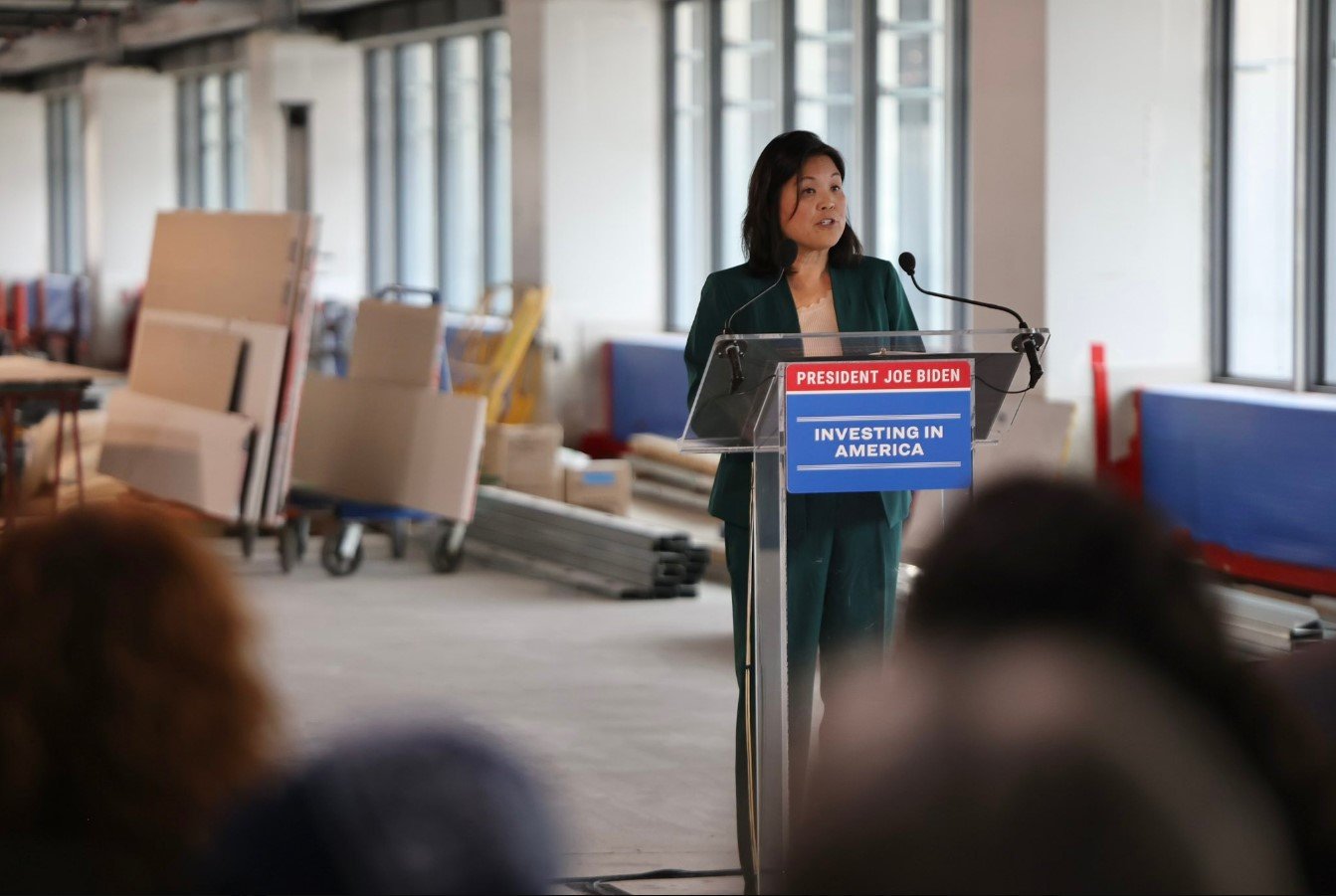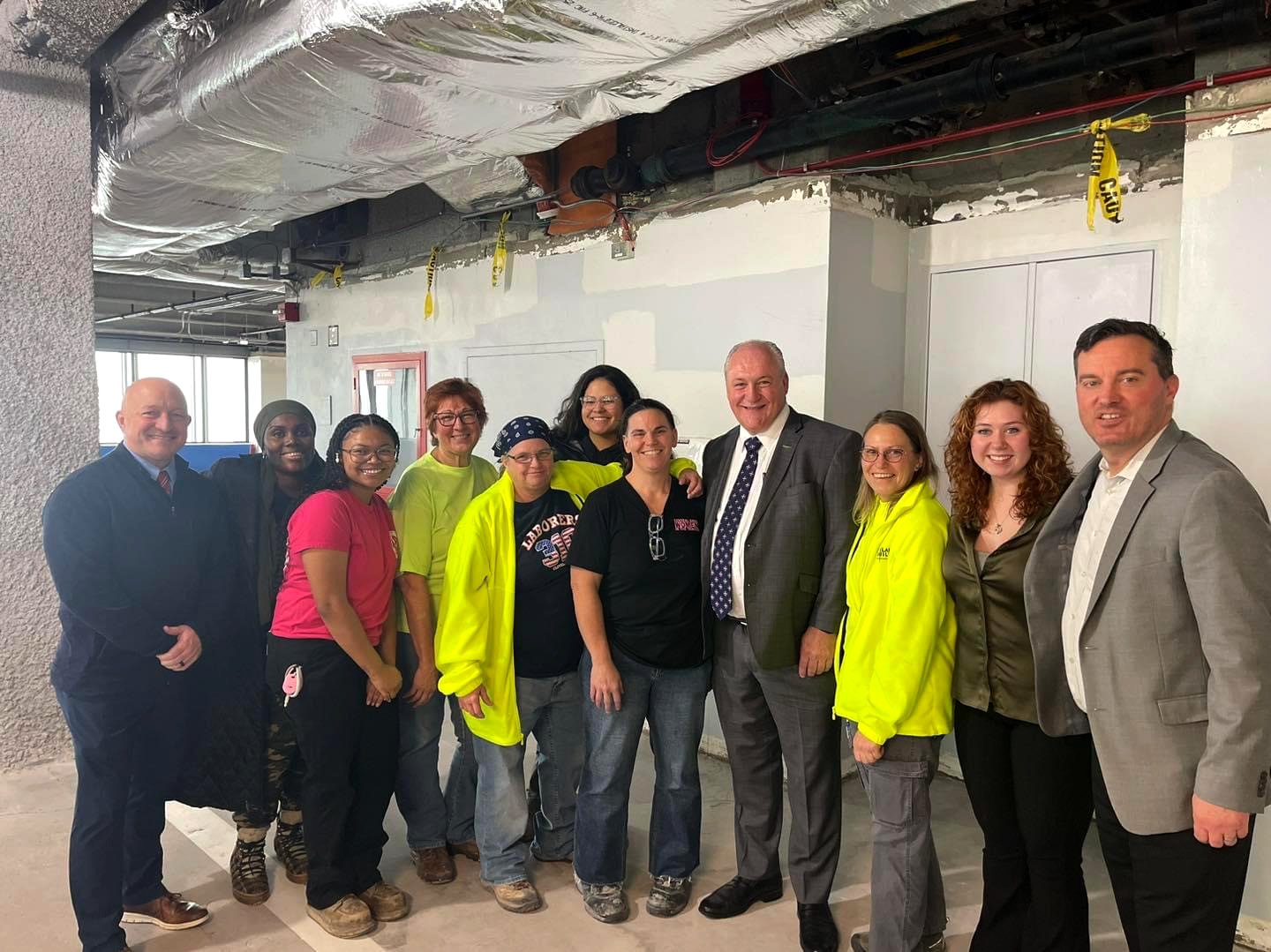Acting U.S. Department of Labor Secretary Julie Su announces final PLA rule in Cleveland
PHOTO: L-R Acting U.S. Department of Labor Secretary Julie Su, Members with Dave Wondolowski, Cleveland Building, Construction Trades Council Executive Secretary/Business Manager Dave Wondolowski
Acting U.S. Department of Labor Secretary Julie Su visited Cleveland in mid-December to announce details related to the final rule to implement President Joe Biden’s Executive Order requiring Project Labor Agreements for most large-scale federal construction projects.
This rule will help ensure large federal construction projects are completed by union construction workers, who will earn good wages and excellent healthcare and retirement benefits in exchange for performing quality construction work efficiently and on time, helping to complete the project on or under budget.
“This is a win all around,” according to the DOL transcript of Su’s speech. “It’s a win for the federal government because when we invest our money, we want the projects done on time, on task and on budget. It’s also a win for the federal government because the President said we'regoing to build an economy that leaves no one behind, and coming to Cleveland and making sure that our federal dollars are being used in a way that lifts up the entire community, is very important to us. And that’s why this is going to be a win all around.”
The announcement took place on Dec. 18 at the Anthony J. Celebrezze Federal Buildingby Su, Administrator of the General Services Administration Robin Carnahan and Deputy Director for Management Jason Miller of the Office of Management and Budget.
Also in attendance were Cleveland Mayor Justin Bibb, U.S. Rep. Shontel Brown (D-Cleveland), North America’s Building Trades Unions (NABTU) President Sean McGarvey,Cleveland Building, Construction Trades Council Executive Secretary/Business Manager Dave Wondolowski, local building trades leaders and members.
“A Project Labor Agreement is a contract between labor and the owner that ensures union labor will be building the project,” Wondolowski told Crain’s Cleveland Business, adding that these pre-hire Collective Bargaining Agreements with building trades unions establish the terms and conditions for the project.
Su called Cleveland a model for the country to follow when it comes to doingconstruction projects right.
“There is this collaboration between contractors and the building trades,” she said.“They've proven that they can do this, and we're using them on federal projects.”
Carnahan described Cleveland as a city that showcases the White House’s investment in the middle class.
“We are here in Cleveland, in part, because Cleveland is a place where we already have ongoing projects under PLAs,” she said to Crains.
In a related prepared statement, Biden stressed the need to build a better America.
“For the first time in history, Project Labor Agreements will be required on federal construction projects valued at or above $35 million,” he said. “This means that projects funded by my Investing
in America agenda will move faster and without delays, giving taxpayers a better bang for their buck. Workers will have the security and peace of mind that collectively bargained wages and benefits bring, better pathways to good-paying jobs, and stronger health and safety protections.”
Miller estimated the Biden Executive Order will benefit about 200,000 workers on 150 large-scale federal construction projects that total nearly $50 billion, according to a Spectrum News report.
Now, nearly two years after Biden first announced the Executive Order on Feb. 4, 2022, the final rule will promote the economy and efficiency on federal projects.
“The efficiencies come from not having to deal with dozens of collective bargaining agreements on each project,” Wondolowski told Crains.
The benefits of PLAs are well-documented, as the agreements have been used in many forms throughout the country in both the public and private sectors for years.
“Time and again, PLAs have proven to address labor supply issues, prevent work stoppages, protect workers’ classification, strengthen health and safety standards and achieve substantial, direct cost savings by standardizing contract terms for highly skilled craft workers,” said McGarvey in a prepared statement. “PLAs also boost community economies through local hiring goals and recruitment of workers into apprenticeship and pre-apprenticeship job training programs that uplift historically marginalized communities into middle-class construction careers.”
In Cleveland, perhaps the best example of a project built under a PLA was the Downtown Hilton Hotel.
Just over $310 million was budgeted for the project, but the 600-room hotel came in $20 million under budget and was finished on time ahead of the Republican National Convention in 2016.
Currently, the Celebrezze Federal Building, which was built in 1967, is undergoing a $54 million, six-floor renovation. Work includes modernizing office spaces, including upgrades to the HVAC, electrical and fire protection systems, plus abatement of asbestos-containing materials.
The work is being performed under a PLA that requires the project to hire individuals who have completed or are in a registered apprenticeship program or an Apprenticeship Readiness Program.
“We also can ensure that the community is going to get a fair share of the work on the project in the body of the PLA,” said Wondolowski to Spectrum.
To help ensure members of the underserved community can benefit from the current construction boom in Northeast Ohio, the City of Cleveland invested $10 million from American Rescue Plan funding into the Cleveland Builds program.
A collaborative effort between the Cleveland Building and Construction Trades Council, the Construction Employers Association, Cuyahoga Community College and the Urban League of Greater Cleveland, the Apprenticeship Readiness Program provides workforce training to create equitable talent pipelines into the area’s building trades unions.
The program’s goal is to enroll 3,000 men and women with training providers and wrap-around services over the next four years.
Bibb feels the Biden order can play an important role and called PLAs an investment as the City and Cleveland Building Trades work to create the pipeline of workers.



